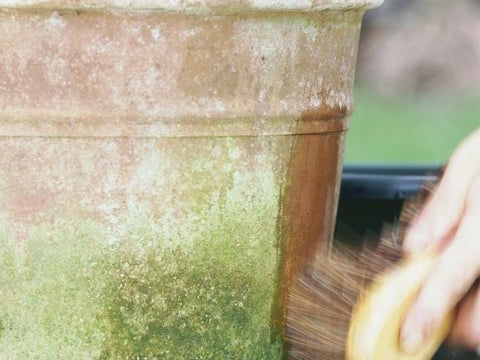Common Plant Diseases and Prevention
Most plant diseases are caused by fungi, others by bacteria or other microorganisms or viruses. Learn how to prevent and treat your plants with these tips.
Plant disease

Keep garden pots and equipment clean and clear of fungus and bacteria. This will prevent carryover of disease to new plants.
Step 1: Check for Disease
Fungi
Fungi that infect plants may consist of microscopic threads; these can grow together to form structures that are visible to the naked eye. The first signs of infection you will notice are usually spots, rots or stem die-back; or you may notice mildew, mold or other evidence of fungal disease.
Typically, airborne fungi produce spores that spread by air currents, rain or watering splash, or, less importantly, on insects or seeds. Spores need moisture to germinate, which is why fungal diseases - mildews and molds, for example - are so much worse in wet weather.
Many fungi also produce resting bodies that survive dry or cold periods. These persist in the soil until better conditions or the presence of a susceptible plant is “detected,” and then release spores that start the disease cycle over again. Fungi also persist in infected plants. Die-back diseases carry over from year to year in infected shoots, and rose black spot will lurk in fallen leaves ready to reinfect roses in spring.
Treatment
- Washing foliage occasionally in mid-morning may disrupt the daily spore-releasing cycle. Neem leaf shineand PM Wash, used on a 7 day schedule, will prevent fungal attack of indoor grown plants.
- Water only in the morning so plants have a chance to dry during the day. Drip irrigation and soaker hoses will help keep the foliage dry.
Bacteria
Bacterial infections can cause a range of symptoms. Rots of soft tissue, such as bulbs and rhizomes, with a distinctive evil smell are often caused by bacteria. Canker, such as bacterial canker of cherries, is also widespread. Another common bacterial disease is fireblight, which affects plants in the apple and pear family, including pyracantha and cotoneaster. Symptoms include dieback of branches, and leaves that hang as if scorched by fire. Fireblight may be spread by insects that carry the bacteria from flower to flower; and like other bacterial diseases may be spread by air currents, or by rain or watering splash. Many need help to enter plants,and gain access through insect pest damage, pruning wounds, or even the scars left from leaf drop in the fall
Treatment
There is no cure for plants infected with bacterial leaf spot. Preventive, organic measures include:
- Spraying with a baking soda solution (a tablespoon of baking soda, 2 1/2 tablespoons of vegetable oil, a teaspoon of liquid soap, not detergent, to one gallon of water), or Bio fungicide (do not use when pollinating insects including bees or other beneficial insects are present). Baking soda may burn some plant leaves. Spray only a few and then check for a reaction before applying applications every two weeks.
- Applying Copper-based fungicides weekly at first sign of disease to prevent its spread. This organic fungicide will not kill leaf spot, but prevents the fungus spores from germinating.
Viruses
Viruses spread when insects carry them between plants. Greenflies or aphids are common carriers, but thrips, whiteflies, and certain other insects play their part. Viruses are widespread in weeds and in most mature garden plants, where their effect is usually not noticeable — robust mature plants are able to stand up to their effects.
Step 2: Prevent and Treat Diseases
Contact fungicides form a protective layer that prevents spores from getting into the plant, but they will not cure infections. Cover the whole plant before the disease gets a grip on it. Prompt application is especially important for young plants, so inspect them regularly. If you leave it too late, they will often die or else are so slowed up in growth that they never make good plants. Older plants can shrug off disease, or at least come back from a bad attack. Viruses are spread by insects, so controlling the insect will help in controlling the spread of the virus
Step 3: Use Chemicals
Spray both the upper and lower surfaces of foliage. Remember to keep pets and children away from the sprayed area until the material has dried onto the leaves.
Reading and following the instructions on the label is vital for safe, effective and legal pesticide use. Calculate how much you need. If in doubt, make up less; you can always mix more. If only a few plants need treating, use a ready-diluted spray formulation.
Take care to avoid spillages and never allow pesticide to get into storm sewers, ponds, streams or ditches. Set nozzles to give a fairly fine spray that neither drifts nor drenches, and apply the spray evenly over the affected plants. Foliar sprays should not be applied so heavily that dribbles occur, but just enough to evenly wet the target.






